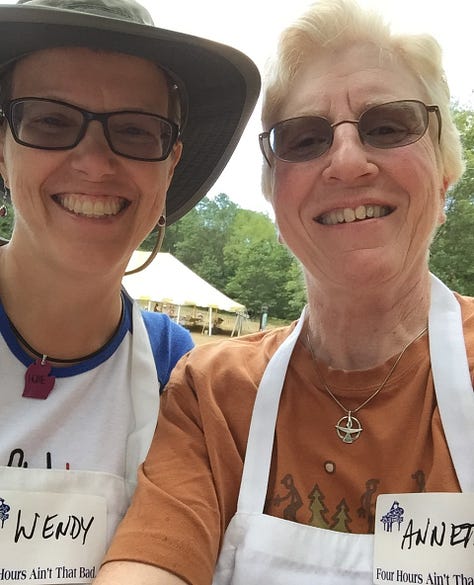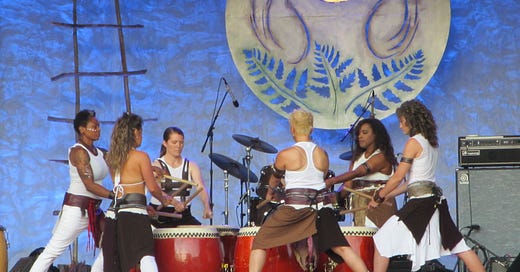Crone. It’s a word I first encountered in my thirties in lesbian circles where women had plucked it from a quagmire of negative associations about ugly and frightening old witches, brushed off the patriarchal muck, and burnished it as a badge for wise woman elders. I appreciated the reframing, but since none of my friends described themselves as crones, I didn’t explore it further.
Then, when I attended my first Michigan Womyn’s Music Festival in August 2015 (the last in its 40-year run), I had a closer encounter with crones. One of the camping areas was even named “Crone Heights” out of respect for wise woman elders. Throughout Michfest, I was struck by the power emanating from many of the women, particularly older women. In the opening ceremony, several women who’d survived breast cancer strode across the stage shirtless, chests flat and scarred on one or both sides, postures proud, eyes gleaming, arms raised up to flex their biceps or pump a fist skyward.
Later in the week, near the day stage, I sat behind an Amazon with biceps the size of my thighs, silver peppering the close-cropped hair under her ball cap, an elaborate labrys tattoo on her left upper arm, its beauty unobstructed by her tank top. As she listened to the music from a low-slung chair she’d placed in a patch of shade, she tapped her foot to the rhythm. . . and knitted, a blanket in muted rainbow hues emerging from the needles that clicked and twirled in her hands. This juxtaposition of strength, resilience, and care epitomizes the feminist, womanist reframing of crone.
While the knitter’s tattoo declared her lesbian and Amazon identities, I’m not certain she considered herself a crone. I didn’t ask, but it’s likely—and ever since that moment, when I hear crone, she’s who I see. Poet and activist Adrienne Rich offered a variation on the “wise woman elder” meaning of crone in her book, Of Woman Born: “The crone is the woman who has lived outside the definitions of others—or who has dared to create her own.” That works too.






What brought this word back to my attention after all these years? An app. A few days ago, when I opened the Insight Timer app to count down my morning meditation, a course popped up called “Feisty Crones.” I like the out-and-proud kind of crone-ness that feisty suggests. Yet feisty also implies that this spiritedness comes from someone seen as small or weak, someone from whom such energy and fight is unexpected.
Despite this baggage, I appreciate that “feisty crones” also conveys a refusal to succumb to the involuntary invisibility that many Americans, especially women, experience as they age. I’ve witnessed this phenomenon when I’m out with older friends: servers or salespeople who don’t seem to see them, customers who walk in front of them, or people who assume they don’t know how to use their iPhone or can’t do something physical like lift a box. I’ve been guilty of the latter two ageist assumptions myself. Thankfully, my friends call me on it.
Some have told me that this involuntary invisibility happens to them in meetings too—at work, church, or in other settings. In such situations, they find ways to assert their presence, but even when they do, it’s sometimes as if their words evaporate in midair before they reach the intended recipient. I don’t want to disappear either.
What might I say instead of feisty? Bold crone? Aging boldly is a sentiment that’s espoused in the [B]old Age newsletter and embodied by women like Nora Langdon, an 81-year-old who became a world-record holder in senior powerlifting after retiring from her career as a realtor at 65. She’d never played sports before and said after her first weightlifting session, “I was aching from the top of my head to the soles of my feet.” But she went back, determined to regain muscle strength. She’s still competing—and doesn’t plan to stop anytime soon.
Regardless of which adjective I land on, I understand why I’m paying closer attention to this concept now. I qualify as a crone. Depending on what you read, women enter cronehood at age 50, 52, 55, 56, 60, or later—if numerical age is the deciding factor. Yet, there are other markers: entering menopause, becoming a grandmother, retiring from full-time employment (if one can and chooses that path), or reaching another milestone meaningful to the woman who’s croning.
This past June, a doctor confirmed that I’ve crossed the menopause threshold. I’ll reach another milestone at the end of this school year: completing my third decade as a public educator. My numerical age continues to move me deeper into the crone zone too. So, what to do? These posts are my meandering way of figuring out the answer to what’s next after full-time librarianship, but here I mean what to do, if anything, to embrace being a crone.
I’m beginning to sense the shift in perspective that May Sarton described in her memoir, Plant Dreaming Deep:
It is only past the meridian of fifty that one can believe that the universal sentence of death applies to oneself. At twenty we are immortal; at fifty we are too caught up in life to think about the end, but from about fifty-five on the inmost quality of life changes because of this knowledge. Time is suddenly telescoped. Life in and for itself becomes more precious than it ever could have been earlier…it is imperative to taste it, to savor it, every day and every hour, and that means to cut out waste, to be acutely aware of the relevant and of the irrelevant.
I’d like to mark this transition. In Western society, rite-of-passage rituals for elderhood were once mainly the domain of women who practiced Earth-based spirituality or identified as Wiccan or Pagan. But in the past twenty years, such celebrations have grown in popularity among women of many faith traditions to honor what Jane Fonda calls the “third act” of life, to express gratitude for living into elderhood, and to push back against our culture’s veneration of youth and beauty—and its erasure of older people.
Whether I call it a croning ritual, a cronehood ceremony, a wise woman elder celebration, or something else, I don’t plan to adopt a new name as some women do, a practice also associated with other rites of passage in some faith traditions. I don’t know when it’ll happen either—this year? next year? when I turn 60?
Whenever it does, what I envision is being encircled by woman friends, some in person and some via Zoom. I envision honoring the women who’ve shaped me, listening to friends share readings about elder womanhood that speak to them, breaking bread together, lighting candles, eating chocolate, sipping wine, telling stories, and maybe, just maybe, if I allow myself to be free enough, if we allow ourselves to be free enough, singing and dancing too.
As I imagine the scene, there’s a little girl in my heart spinning with her arms outstretched and eyes closed. Crone. It’s a word with wings.

Here’s a poem for your pocket until the next post: “Now I Become Myself” by May Sarton.
What’s your experience with elderhood? With involuntary invisibility? With rites of passage that honor the wisdom and experience of old age? Consider adding a comment to share your insights.




One of the most empowering experiences I had was throwing myself a 60th birthday party in Victoria, BC. I invited some family, some friends, to join me for a weekend. That people came, some from all the way across the country, meant so much to me, and the whole weekend I felt so loved and supported as I joined a new age group (as my running friends said, which was true!). I didn’t realize it at the time, but it started that new decade off for me in the best possible way. So I highly recommend a crone party/celebration of some sort at a time that feels right for your life.
The five beautiful, strong elder women in my writers group have all been celebrated with croning rituals. We would love to talk to you about crowning!